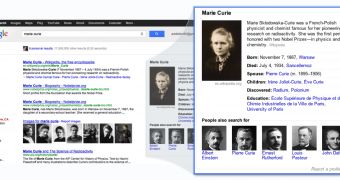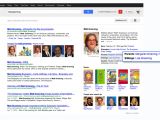Google has started rolling out the semantic search update we've been hearing about all year. The feature actually started showing up in searches over the last few days and has been in testing for a lot longer than that.
It may not seem like it at first, but the new Knowledge Graph is a major update for Google, not just design wise, but on how the actual search works.
What's different and new about the Knowledge Graph is that Google finally understands what the queries mean, not just what they spell out.
"Take a query like [taj mahal]. For more than four decades, search has essentially been about matching keywords to queries. To a search engine the words [taj mahal] have been just that—two words," Google explains.
But anyone can tell you that Taj Mahal is a famous landmark in India and may even be able to tell you a couple of things about its history.
That's just one aspect though, there's also a musician going by the same name, a well known casino in Atlantic City and numerous local businesses using the name.
"It’s why we’ve been working on an intelligent model—in geek-speak, a “graph”—that understands real-world entities and their relationships to one another: things, not strings," Google added.
"The Knowledge Graph enables you to search for things, people or places that Google knows about—landmarks, celebrities, cities, sports teams, buildings, geographical features, movies, celestial objects, works of art and more—and instantly get information that’s relevant to your query," it said.
Google has been working on this for the past couple of years, after its acquisition of Metaweb. It sources its data from places like Freebase or Wikipedia but also licenses data from several provider.
Key to all of this is getting as much data as possible, more data will always make the results better. Of course, a huge part of the data behind the knowledge graph comes from Google itself, especially, what people search for.
This is what enables Google to build relationships between objects and concepts, by seeing which things people search for together.
Based on the knowledge Google builds on objects and, importantly, the relationships between them, Google now displays an info box to the right of the regular search results, which remain unchanged.
Google's got data on 500 million objects with 3.5 billion facts about them. It will selectively show those facts in the info boxes depending what the objects stand for, i.e. songs for famous musicians, location for famous places and so on, and on the object of the search.
Beyond info about the query, Google also suggests a new set of search results for the same query but with a different meaning, like the musician in the Taj Mahal example above instead of the monument.
It will also suggest searches for things related to the original query, the lead actors if you're searching for a TV show for example.
The info boxes serve two purposes this way, one is to inform by providing direct answers to queries Google can answer itself, and the other is to provide additional context via related searches. The feature is rolling out for the global Google.com in English right now.

 14 DAY TRIAL //
14 DAY TRIAL // 

